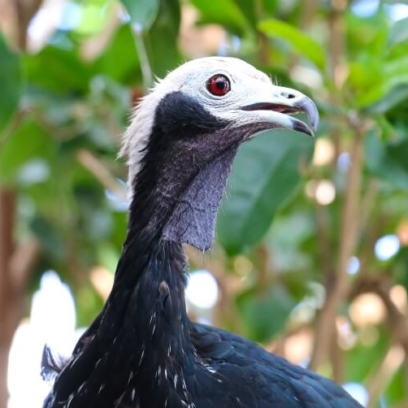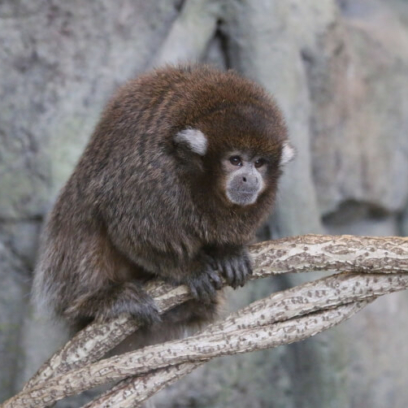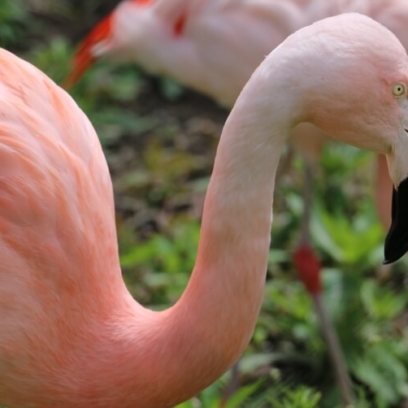Giant Otter
Pteronura brasiliensisIsn’t it Wild? Two or three weeks after giant otters are born; the mother puts her babies in the water where they learn to swim. In a month or two, they will become proficient swimmers and can hunt with the rest of their family.
There’s More to the Story Delightful, amazing, captivating, engaging and VERY LOUD – all describe one of the most endearing species in the Faces of the Rainforest exhibit – the giant otters. These inquisitive social and noisy animals are members of the weasel family and cousins to North American river otters and sea otters. This species of otter may have up to nine distinct sounds, and possibly more. The giant otter can grow to more than 6 feet long and weigh up to 70 pounds, nearly twice as large as the little river otters Zoo guests visit in the World of Adaptations.

When walking through the Faces of the Rainforest, guests will hear interesting vocalizations and see the antics of Romo and Fernando. Like children, they play hard, but need time to recharge before embarking on games on the water slide and in the pool. The two otters have two different personalities. Romo, who is distinct with a large area of white fur under his chin, is very curious. He may even swim up close to the window in his habitat to greet visitors. Fernando is a rather shy, and takes a little longer to warm up. To stay healthy these active critters’ diet consists of a variety of fish including herring, tilapia, and trout fed to them four times a day.
Giant otters swim by propelling themselves with their powerful tails and flexing their long bodies. They have webbed feet, water-repellent fur to keep them dry and warm, and nostrils and ears that close in the water. Their whiskers, which are called vibrissae, are used to detect changes in currents and water pressure. This helps when they are searching for fish and other prey because they can detect the prey’s movement.
Sadly, giant otters are an endangered species. This compelling animal once populated the tropical rainforests of the Amazon, down to Brazil’s Pantanal, the world’s largest wetland. Today the giant otter only lives in the most remote waters in tropical South America. Hunting for their luxuriant fur, along with habitat loss, has greatly reduced their numbers to an estimated 2,000 to 5,000 total in the wild. Please visit Romo and Fernando and learn how you can help be a part of the solution to save the flora and fauna of the rainforest.
Details
Length: 5 – 6 ft.
Weight: Male 70-100 lbs; Female 48-57 lbs.
rainbow trout, carp, river Fish, tilapia, red eye, bream, herring, mackerel, channel catfish, perch
South America: Orinoco, Amazon and La Plata River systems, Argentina, Bolivia, Brazil; Colombia, Ecuador, French Guiana, Guyana, Paraguay, Peru, Suriname, Venezuela
Endangered
Faces of the Rainforest
Exhibit information
Journey to the Amazon rainforest! Get a glimpse of the rare South American giant river otter. Giant is right! A full-grown otter can reach lengths of up to six feet long!
Wait until you meet the Titi monkeys who mate for life. They can typically be seen sitting or sleeping in pairs with their tails intertwined.
Do you hear that sound? That’s a howler monkey’s call, often heard at a distance of up to two or three miles away!
These animals are just some of the fascinating creatures you’ll discover in the Zoo’s awe-inspiring Faces of the Rainforest exhibit. They’ve joined some of your old favorites like the giant anteater, Chilean flamingos, and white-faced saki monkeys. Whether you’re interacting with toucans and troupials (troupials are a large passerine bird species found in Central America and tropical South America) inside the exhibit’s free-flight aviary or viewing a massive anaconda and stunning tropical fish, this immersive wildlife experience will take you on a journey to the depths of the Amazon Rainforest. Visitors will discover how these diverse species—big and small—create the complex ecosystem on which rainforests thrive, and what we can all do to ensure their survival.
Did you know that 80% of rainforest deforestation is caused by agriculture? Natural habitat is being destroyed to clear land for ranches and plantations. But simply by choosing to purchase sustainably grown products, you can make a difference.
One way to help protect the rainforest is to “Follow the Frog”! Just look for the Rainforest Alliance seal on products ranging from bananas and chocolate to coffee and flowers. Click HERE for a list of Rainforest Alliance certified products




